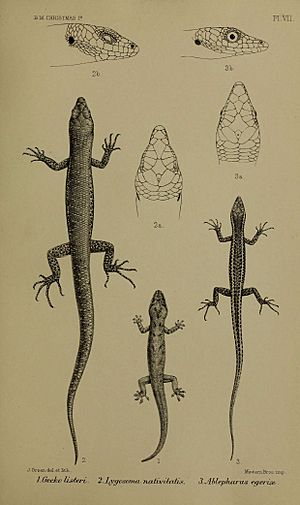Lister's gecko facts for kids
Quick facts for kids Lister's gecko |
|
|---|---|
 |
|
| L. listeri, figure 1 (centre). | |
| Conservation status | |
| Scientific classification | |
| Genus: |
Lepidodactylus
|
| Species: |
listeri
|
| Synonyms | |
|
|
The Lepidodactylus listeri, also known as the Lister's gecko or the Christmas Island chained gecko, is a type of gecko. Geckos are small lizards that belong to the family called Gekkonidae. This special gecko only lived on Christmas Island in the Indian Ocean. Sadly, it is now considered extinct in the wild, meaning it no longer lives freely in nature.
Contents
Where Does the Lister's Gecko Live?
The Lister's gecko is an endemic species. This means it was found only on Christmas Island. Christmas Island is a small piece of land in the Indian Ocean.
What's in a Name?
The name listeri and the common name "Lister's gecko" are a tribute. They honor a British naturalist named Joseph Jackson Lister. He was a scientist who studied nature.
What Does the Lister's Gecko Look Like?
The Lister's gecko is a brown lizard. It grows to about 5 cm (2.0 in) long from its snout to the base of its tail. It has a wide, light fawn or grey stripe down its back. This stripe gets wider on its head. The stripe also matches the color and pattern of its tail. Its belly is whitish. The gecko's body is covered with small, smooth scales.
This gecko used to live mostly in thick, natural rainforests. These forests were found on the high parts of Christmas Island. It also lived in areas where the forest had been disturbed. However, it was never found in parts of the island where mining had taken place.
How Is the Lister's Gecko Related to Other Geckos?
The Lister's gecko is closely related to other geckos in the Lepidodactylus group. These relatives are from places like the Mollucas and the Philippines. Scientists believe the Lister's gecko separated from these relatives about 26 million years ago.
One of its relatives, L. lugubris, can reproduce without a male. This is called parthenogenesis. However, the Lister's gecko reproduces in the usual way, with both male and female geckos.
Why Did the Lister's Gecko Disappear?
In 1979, the Lister's gecko was common across Christmas Island. But by 1998, scientists started to notice fewer geckos. Their numbers kept dropping in 2004 and 2008. By 2009, it was clear the species was in great danger. So, a program was started to breed them in captivity. The last time a Lister's gecko was seen in the wild on Christmas Island was in October 2012.
Many other native animals on Christmas Island also started to disappear around the same time. Scientists think there might be a common reason for this decline. One main suspect is the wolf snake (Lycodon capucinus). This snake was brought to the island around 1982. It is believed that these snakes ate many of the geckos.
What Is Being Done to Help the Lister's Gecko?
Before the Lister's gecko completely disappeared from Christmas Island, 43 geckos were taken into human care. This started in August 2009. The goal was to create a group of geckos that could breed safely. This plan worked very well! By July 2022, there were over 1500 Lister's geckos in captivity.
However, it's not likely they will be put back into the wild soon. The threats that caused their decline on Christmas Island are still there. Scientists also sequenced, or mapped, the entire genetic code of the Lister's gecko in 2022. This helped them learn that the geckos have a lot of genetic variety. This is good because it means the captive population is healthy. Even though only 43 geckos started the captive group, there is no sign of inbreeding.
See also
- List of reptiles of Christmas Island


